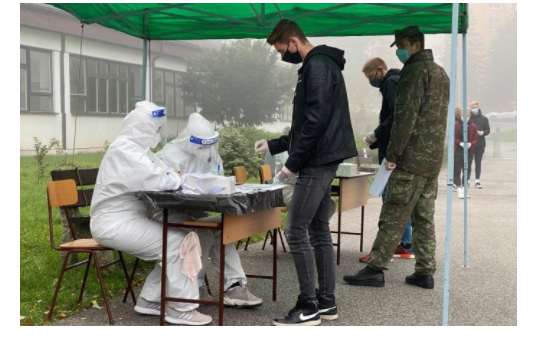Alarmed by a growing number of cases of Covid-19 but reluctant to impose a severe lockdown which Prime Minister Igor Matovič claimed would cost the economy between 80-100M€ per day[1], the Slovakian government decided to screen its entire population of 3.6 million people in an effort to stop the chains of transmission of the virus. The first results of the mass screening are impressive, with 57,402 asymptomatic carriers identified and isolated and thus 57,402 chains of transmission broken.
But just how did they do it?
The Slovakian government made their decision on October 13 to move forward with “Operation Common Responsibility”[2]. They ordered 13 million tests at a cost of 50 million euros from a supplier in South Korea. While critics complained that the tests weren’t sensitive enough, the government relied on the fact that the false negatives would most likely be the least infectious and that a second round of testing would likely catch any missed cases. In addition, hygiene and social distancing protocols remain in place throughout the country.
Pilot program in high infection areas and with vulnerable communities
The government began with a pilot program that targeted high infection rate areas as well as nursing homes and essential government workers. This provided an opportunity to test the system as well as begin the testing in the most urgent areas. During the pilot testing on October 23rd, they reached 140,951 people out of the target 155,000, and found 5,594 asymptomatic carriers, who were then isolated[3]. This was an important initial success.
Organized by government, military, health professionals and community
Next, the government enlisted the military to organize the two-weekend mass screening, dividing the country into 16 regional headquarters with 5000 testing spots. The government offered financial incentives (on the order of 900€) to attract the 15,000 necessary healthcare professionals to administer the tests. An additional 19,000 community volunteers signed up to help with logistics.
Each municipality then organized its own testing teams and locations, taking advantage of the existing structure for elections, as well as the polling places themselves: schools, community centers and local government buildings. For example, with a population of 25,000 people, a municipality might set up “18 testing spots with 7 testing sites, aiming to process 800 people per testing spot, with an average of 35 people tested per hour”, as described in the Behavioural Insights Team report[4]. Some used webcams and social network apps to encourage participation and to reduce congestion and wait times.
How did they get people to participate?
In order for massive screening to work, the government had to get the entire population to participate. They did this with a two-pronged strategy: the carrot and the stick. First, Slovakians were under strict lockdown for three weeks prior to the testing, not allowed to go out except to work and for essential purchases. Secondly, the tests were not obligatory but anyone who opted out would have to completely self-isolate for the 10 day period of the tests. This meant that it was necessary to take the test to be able to go to work. Conversely, people who took the test and got negative results would not have to self-confine. The government has issued health certificates with the results of the test and anyone found in public without one can be fined 1650€[5]. Employers and shop owners have been checking the certificates to ensure compliance.
But for the most part, it seems that the steep fines have not been necessary. 97% of the target population between 10 and 65 participated in the testing[6].
Result: 57,402 chains of transmission broken
The results have been remarkable: over the course of the two weekends Operation Common Responsibility has identified, and almost more importantly, isolated 57,402 infections thanks to the antigen tests. For comparison, since March, with PCR testing they had only diagnosed 76,072 cases[7]. While the PCR test may be more accurate in a given situation, it is clear that if the test isn’t administered—because of cost, complexity or need for a laboratory analysis—no accurate result can be obtained. In the case of Slovakia, more tests means more chains of transmission identified and broken.
The Slovakian government reported that the rate of infection has fallen 58% from 1.47% to 0.62%. For now, the world will be watching[8]. As the Financial Times reported “Slovakia’s experience showed that for small countries, rapid mass testing in conjunction with other tools such as quarantines and social distancing, could prove useful for fighting the pandemic.[9]”
Notes
- [1] “Slovakia to test all adults for SARS-CoV-2”, in The Lancet.
- [2] “How Slovakia tested 3.6 million people for COVID-19 in a single weekend” in The Behavioural Insights Team
- [3] The Lancet
- [4] The Behavioural Insights Team
- [5] The Lancet
- [6] The Behavioural Insights Team
- [7] US News and World Report: “Slovakia Says COVID Double-Testing Cut Number of Infections by More Than Half”
- [8] Ibid.
- [9] Financial Times: “Slovakia’s mass coronavirus testing finds 57,500 new cases”

